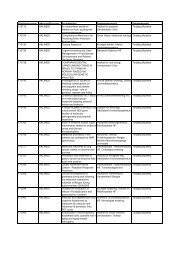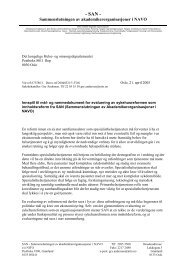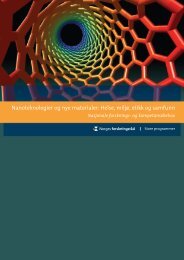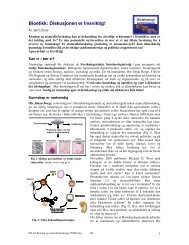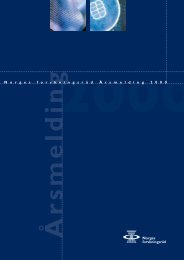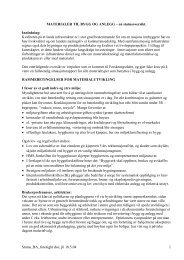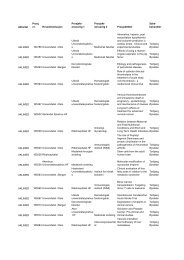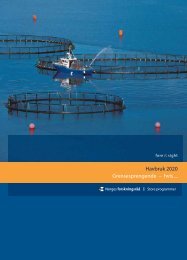A Revolution in R&D
A Revolution in R&D
A Revolution in R&D
Create successful ePaper yourself
Turn your PDF publications into a flip-book with our unique Google optimized e-Paper software.
38<br />
Side-effect-based pharmacogenetics for common side effects<br />
can save a candidate drug that would otherwise fail.<br />
This form of pharmacogenetics does not streaml<strong>in</strong>e<br />
trials; <strong>in</strong> fact, it imposes a moderate <strong>in</strong>crease <strong>in</strong> costs,<br />
s<strong>in</strong>ce more patients have to be recruited <strong>in</strong>itially for<br />
the vett<strong>in</strong>g process. It requires a smaller upside to<br />
break even than efficacy-based pharmacogenetics,<br />
however, s<strong>in</strong>ce its powers of exclusion apply only to<br />
the second type of patient (those who would ord<strong>in</strong>arily<br />
try the drug and then discont<strong>in</strong>ue it). They do<br />
not apply to the first group (those who would take a<br />
full course of the drug), s<strong>in</strong>ce placebo responders<br />
do not suffer from side effects.<br />
Side-effect-based pharmacogenetics for very rare side effects<br />
is the type that would be applied for a drug already<br />
on the market. Once the number of adverse events<br />
(<strong>in</strong>stances of severe side effects) reaches a critical<br />
mass, the drug’s reputation suffers, and its cont<strong>in</strong>ued<br />
marketability is jeopardized. (In severe cases,<br />
regulatory agencies require the drug to be removed<br />
from the market.) To salvage it would <strong>in</strong>volve implement<strong>in</strong>g<br />
screen<strong>in</strong>g tests for all potential patients—<br />
a k<strong>in</strong>d of postmarket surveillance. This type of<br />
pharmacogenetics would <strong>in</strong>crease costs fairly<br />
steeply, yet it could still make economic sense if the<br />
drug were saved.<br />
The economics h<strong>in</strong>ge on a paradox: the fewer the<br />
adverse events, the harder it might be to save the<br />
drug. To identify the culprit genetic marker for use<br />
<strong>in</strong> the screen<strong>in</strong>g test, you need a certa<strong>in</strong> m<strong>in</strong>imum<br />
number of patients who have experienced the side<br />
effect. That could be as low as 20 (assum<strong>in</strong>g you<br />
achieved a 100 percent association with a s<strong>in</strong>gle<br />
SNP marker), and that would carry the modest<br />
price tag of $100,000 (assum<strong>in</strong>g the expected genotyp<strong>in</strong>g<br />
cost of one cent per SNP). But the required<br />
number could be 2,000 (assum<strong>in</strong>g you achieved<br />
only a 10 percent association), and the likelihood is<br />
that such a number of side-effect sufferers would<br />
simply never emerge.<br />
It’s a crime that a very small percentage of patients<br />
can sometimes elim<strong>in</strong>ate an otherwise highly beneficial<br />
drug from the market. Pharmacogenetics benefits<br />
everyone here.<br />
—Research executive,<br />
lead<strong>in</strong>g pharmaceutical company<br />
F<strong>in</strong>ally, market-expansion pharmacogenetics for the<br />
most part has highly favorable economics. S<strong>in</strong>ce its<br />
effect is to expand rather than contract the market,<br />
all it needs to ensure is that the expansion be large<br />
enough to cover the cost of the required trial.<br />
The prospects h<strong>in</strong>ge to some extent on the <strong>in</strong>cidence<br />
of the genetic variant. Consider two drugs,<br />
one produc<strong>in</strong>g side effects <strong>in</strong> poor CYP2D19<br />
metabolizers (<strong>in</strong>clud<strong>in</strong>g 20 percent of Asians) and<br />
the other <strong>in</strong> poor CYP2D6 metabolizers (<strong>in</strong>clud<strong>in</strong>g<br />
7 percent of Caucasians); and suppose that dosage<br />
adjustments could resolve the side effects. It might<br />
turn out that the former case warrants the <strong>in</strong>vestment<br />
and the latter does not, given the difference<br />
<strong>in</strong> their potential market expansions.<br />
All <strong>in</strong> all, these limitations reduce the expected sav<strong>in</strong>gs<br />
that pharmacogenetics would bestow on an<br />
average drug to about $75 million. But of course<br />
there is no such th<strong>in</strong>g as a true “average” drug. In<br />
some cases, pharmacogenetics could yield potential<br />
sav<strong>in</strong>gs as high as $335 million and potentially capture<br />
additional upside through price premiums or<br />
an <strong>in</strong>crease <strong>in</strong> market share. In other cases, it might<br />
save noth<strong>in</strong>g, or even destroy value <strong>in</strong> the market.<br />
The key to success is to be selective.<br />
Implement<strong>in</strong>g Pharmacogenetics<br />
Although the sav<strong>in</strong>gs atta<strong>in</strong>able through pharmacogenetics<br />
appear less dramatic than those atta<strong>in</strong>able<br />
through disease genetics, they are <strong>in</strong> the right circumstances<br />
quite substantial. And the total value<br />
added would be enormous if the hoped-for market<br />
advantages were realized.



